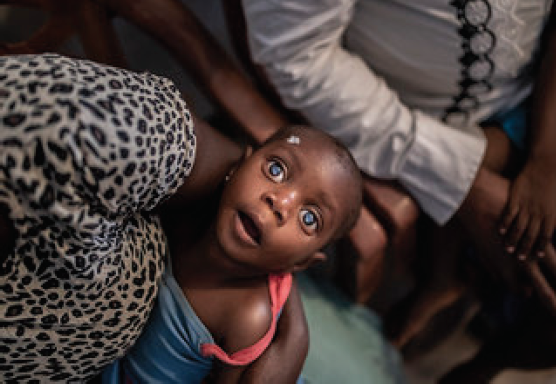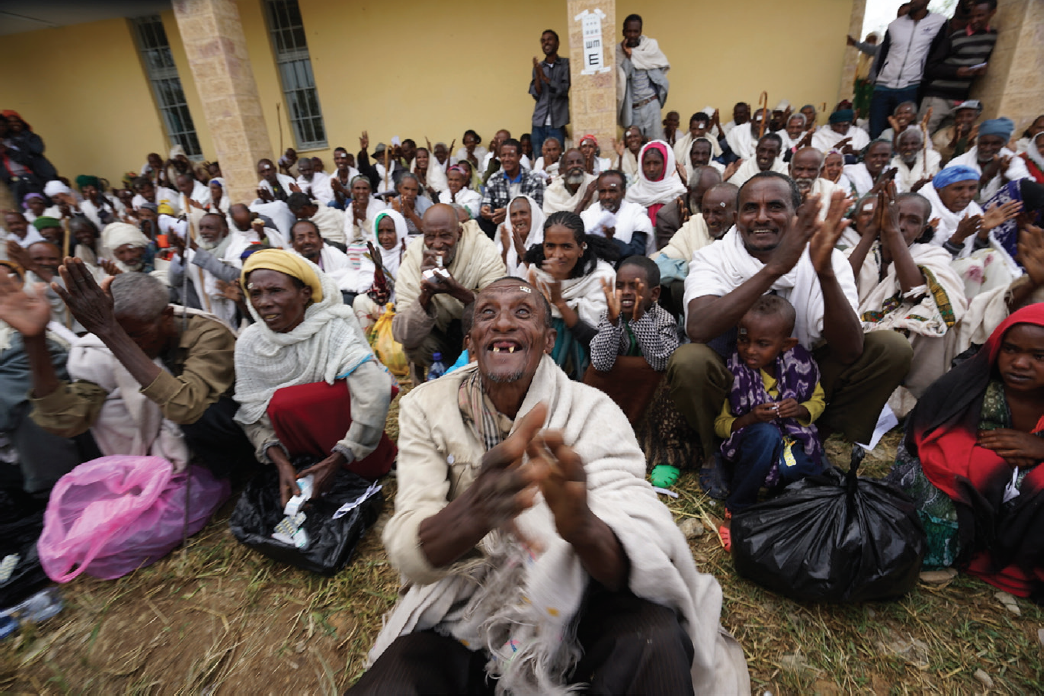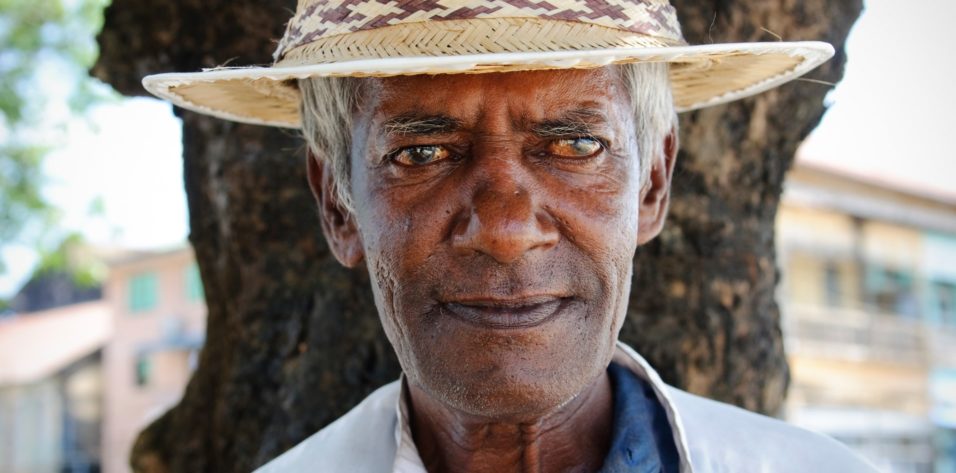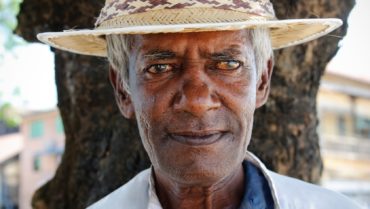

Patali Gurung sat hunched in the corner of a smoky hut near Rasuwa, Nepal, at an elevation of 9,000 feet. Shining snow-covered mountains loomed above, the peaks of which she had not seen in 5 years. Outside, she could hear her grandchildren laughing and playing, but she had never seen their faces. Depressed and hungry, Patali felt like a burden to her struggling family and waited only for death. Her husband, Nabin, however, had heard of a team that was performing eye surgery at a clinic just 30 miles from their home. He placed his frail wife in a basket and trekked for 2 days with his wife on his back. When our team met Patali, we were shocked to learn that her age was only 56. She looked decades older.
The next day, after her cataract surgery, when we removed the bandages from her eyes, Patali blinked and slowly took in the world around her. Shock turned to disbelief, and then a smile as bright as a Himalayan peak spread across her face. When she saw her grandchild for the first time, tears of joy flowed down her cheeks. Within a day she was walking erect, laughing, and looking years younger. She was excited to walk home and to care for her family once again.
EFFECTS OF BLINDNESS
It is a travesty that there are still 16 million people like Patali in our world—16 million left blind by a treatable condition, needlessly left unable to perform the tasks of daily living. In much of the world, it is still accepted that, when you grow old, first your hair turns white, then your eyes turn white, and then you die. Of those burdened with blindness, 90% live in low-resource countries, and the consequences of blindness there are dire.
The life expectancy for someone who is blind in the developing world is one-third that of his or her healthy peers. For blind children, the fate is even worse, with staggering rates of mortality in the first year of losing vision (Figure 1). The devastation extends beyond the sightless individual, affecting entire families and communities. Blindness takes an able-bodied person out of the workforce: Children are often pulled from school to care for a blind parent, sibling, or neighbor. Blindness perpetuates poverty, and poverty, in turn, magnifies the suffering of sightlessness.

Figure 1. A portrait of a child with bilateral cataract, who is waiting for surgery in Basankusu, Democratic Republic of the Congo.
Courtesy of Andras D. Hajdu and the International Agency for the Prevention of Blindness
In the 2019 World Report on Vision, the World Health Organization (WHO) outlined the current scope and impact of vision loss worldwide.1 Blindness is rated the “most feared ailment” by many, frequently more feared than cancer or other morbid conditions. Moderate vision impairment (vision worse than 20/60 in the better seeing eye) is estimated to affect more than 250 million people worldwide. Refractive error (123 million), cataract (65 million), age-related macular degeneration, glaucoma, corneal opacities, and diabetic retinopathy are the leading causes of blindness. Even moderate vision impairment has profound effects on motor and cognitive development in young children, on educational achievement and self-esteem in older kids, and on workforce participation and quality of life in adults. As world demographics change, the numbers affected in these myriad ways will swell.
DISTRIBUTION OF GLOBAL BLINDNESS
Although the consequences of vision loss span the entire arc of life, their distribution across the globe is not equitable. The WHO report emphasizes that lower-income regions, underserved populations, and rural communities are disproportionately affected by vision problems. Particular areas experience huge burdens of disease: The rates of bilateral blindness in regions of South Asia and Sub-Saharan Africa are eight and 10 times higher, respectively, than in high-income countries. These inequities exist because the majority of the causes of blindness are either avoidable or treatable, but the solutions are simply not available to people in poorer areas of the world. The report estimates that the investment gap to address refractive error and cataract, the two leading causes of vision loss, is only $14 billion for the entire world. Closing the chasm that this value represents and reaching the many people who are living with needless blindness are goals that inspire our work at the Himalayan Cataract Project (HCP).
HCP’s WORK
For the past 25 years, HCP has been caring for the blind and helping build eye care systems. Our work started in Nepal, where an estimated 250,000 people were blind from cataracts and where the rate of surgery wasn’t sufficient to treat the new patients each year. We focused on reaching patients where they lived and on building a robust system for training Nepalese eye care providers. As a result of these efforts, the number of people blind from cataracts has been reduced by 70%, and more than 300,000 cataract surgeries are now performed each year in Nepal.
Committed to quality care, we demonstrated in a randomized control trial that manual small-incision cataract surgery (MSICS) has equivalent outcomes to phacoemulsification.2 By streamlining the production process, we have been able to drive down the material costs of these surgeries to less than $25 for MSICS and $70 for phacoemulsification. We established a center of excellence in Nepal to help train the doctors, nurses, and technicians needed to sustain the eye care system. Building on this experience, we have expanded our efforts to neighboring countries in Asia and to countries in eastern and western Sub-Saharan Africa (Figure 2).

Figure 2. Joyful patients await cataract surgery at Arba Minch Hospital in Ethiopia.
Courtesy of Himalayan Cataract Project
THE CHALLENGE REMAINS
Through our work, alongside that of many great partners, organizations, and individuals, much progress has been made across the globe. Many low- and middle-income countries have increased their rates of cataract surgery. India, for example, increased its rate by almost ninefold. And a meta-analysis found that the prevalence of vision impairment and blindness has decreased globally.3
But the problem of cataract blindness, a completely curable condition with devastating effects, still needs greater focus. It is tragic and morally wrong that, in 2020, millions of people remain needlessly blind when effective cataract surgery can be delivered for such a small material cost. Furthermore, several studies have shown a direct return to the economy of $4 for every $1 spent on sight restoration. Despite knowing how to cure a disease and having an economic incentive to do so, governments and large philanthropic organizations still do not provide the few billion dollars needed to overcome needless blindness. The global challenge continues to be in mustering the collective will and financial resources necessary to deliver quality care to the poorest of the poor.
Rethinking benchmarks
As we mobilize resources, it is important to ensure that our efforts are intentional. For many years, the international benchmark for cataract care has been the cataract surgery rate—the number of operations done per 1 million population. In many countries, eye care systems are so nascent that this is an appropriate measure to monitor. As the quality of eye care improves, however, this rate becomes less informative. With better access, the threshold at which patients have surgery falls. They don’t wait as long to access care. People seek surgery when their vision is 20/100 instead of hand motions.
Although this represents systemic progress, it dramatically increases the population that an eye care system must be equipped to serve. This shift also risks leaving behind those who need care the most. Patients seeking earlier surgery are often able to pay, whereas those completely blind from cataracts are more likely to be destitute. Markets prioritize the former over the latter. The cataract surgery rate may be stable or increase over time, but the poorest blind patients may be excluded without intentional systems. As we move forward, we must continue to focus on caring for those most in need.
Adopting compassionate capitalism
One approach to linking quality-driven demand and care for the poorest blind has been termed compassionate capitalism. This system has been effective in Nepal and India, where the majority of blindness is from cataracts. In this approach, part of the revenue from cataract surgery patients who can pay for their surgery is used to fund free operations for those who cannot pay. These surgeries are done in the same hospitals, by the same surgeons, so the quality is the same regardless of the patient’s means. This avoids solely focusing on patients who can pay and creating a second-tier system to care for the poor. Instead, the rising demand for quality eye care sustains surgeries for those in need.
allocating eye care geographically
Another key aspect of reaching those who most desperately need help is focusing on the geographic allocation of eye care. In many developing countries, there are not enough ophthalmologists, ophthalmic nurses, and primary care workers trained to recognize eye disease. For example, the United States has one ophthalmologist per 18,000 people, whereas Ethiopia has one ophthalmologist per 1 million people. The distribution of these scarce surgeons in poor countries exacerbates this problem further. Ophthalmologists cluster in cities, leaving large populations outside these areas without access to trained professionals.
National policies that encourage physicians to return to regions of need after their training are important, as is providing ongoing training and support to these providers. Outreach campaigns are also integral to caring for a country’s entire population. Instead of depending on impoverished patients to transport themselves to major centers, surgical outreach programs bring the care to those patients. Ghana started a National Cataract Outreach Program that has succeeded in consistently increasing the number of blind patients cured by cataract surgery in the country. Eye disease disproportionately affects poor and rural populations, and it is imperative that our approaches target those populations.
AN ATTAINABLE GOAL
Concerted efforts to build eye care systems, train professionals, and treat patients have resulted in many gains. We know how to provide high-quality, cost-effective care to patients blind from cataracts. We have better methods for training ophthalmologists, nurses, and technicians to build a country’s capacity to sustain care as demographics change. But, as the WHO World Report on Vision clearly describes, there are still too many people across the globe unnecessarily blind. We have the cure. We must increase our focus and refine our work so that we can overcome this problem.
As we redouble our efforts, as we are operating, teaching, and up-scaling our efforts, it is essential to maintain an unrelenting focus on our patients. Although the statistics indicate that the number of blind individuals on our planet remains overwhelming, we are curing people as we work. Each person is not a statistic but an individual who can have his or her sight and life restored.
In the world of global health there are few areas in which we can absolutely win. Helen Keller said, “Because I cannot do everything, I will not refuse to do something I can do.” Eliminating needless blindness is something we can do.
1. World Report on Vision. World Health Organization. October 8, 2019. who.int/publications-detail/world-report-on-vision. Accessed December 2, 2019.
2. Ruit S, Tabin G, Chang D, et al. A prospective randomized clinical trial of phacoemulsification vs manual sutureless small-incision extracapsular cataract surgery in Nepal. Am J Ophthalmol. 2007;143(1):32-38.
3. Bourne RRA, Flaxman SR, Braithwaite T, et al. Magnitude, temporal trends, and projections of the global prevalence of blindness and distance and near vision impairment: a systematic review and meta-analysis. Lancet Glob Health. 2017;5(9):e888-e897.


